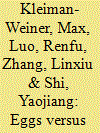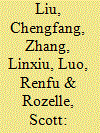|
|
|
Sort Order |
|
|
|
Items / Page
|
|
|
|
|
|
|
| Srl | Item |
| 1 |
ID:
145579


|
|
|
|
|
| Summary/Abstract |
The general goal of the present study is to analyze whether children with siblings lag behind their only-child counterparts in terms of health and nutrition, cognition and educational performance, and non-cognitive outcomes. We draw on a dataset containing 25 871 observations constructed from three school-level surveys spanning four provinces in China. The analysis compares children with siblings and only children aged 9 to 14 years old in terms of eight different health, cognitive and non-cognitive indicators. We find that with the exception of the anemia rate, health outcomes of children with siblings are statistically indistinguishable from those of only children. In terms of cognition, children with siblings performed better than only children. Moreover, outcomes of children with siblings are statistically indistinguishable from those of only children in terms of the non-cognitive outcomes provided by measures of anxiety. According to our results, the same general findings are true regardless of whether the difference between children with and without siblings is disaggregated by gender.
|
|
|
|
|
|
|
|
|
|
|
|
|
|
|
|
| 2 |
ID:
120601


|
|
|
|
|
| Publication |
2013.
|
| Summary/Abstract |
This paper contributes to the assessment of China's rural labor markets. According to our data, the increase in off-farm employment that China experienced during the 1980s and 1990s continued during the 2000s. Our analysis shows that migration has become the most prevalent off-farm activity, although the destination of migrants is shifting from outside of one's province to destinations closer to home. The present paper finds that large shares of male and female individuals, especially those under 40 years, are working off the farm. These findings represent an important contribution to the labor economics field. First, the results of the present paper reveal that the labor transition from the agricultural sector to the non-agricultural sector for key segments of China's rural labor force is nearly complete. Second, although a large share of China's rural labor force work in agriculture, most of these workers are older men and women (and likely would not be willing to take low-wage, labor-intensive jobs). Third, the rising unskilled wage rate in China is partially a result of the tightening of the labor force in the young age cohorts. Finally, due to factors associated with the one child policy and other demographic transition forces, successive age cohorts will continue to fall in absolute number in the coming decade. Assuming China's growth continues, we expect to see further wage increases since it will take higher wages to coax more workers to work off the farm.
|
|
|
|
|
|
|
|
|
|
|
|
|
|
|
|
| 3 |
ID:
119213


|
|
|
|
|
| Publication |
2013.
|
| Summary/Abstract |
Despite growing wealth and a strengthening commitment from the government to provide quality education, a significant share of students across rural China still have inadequate access to micronutrient-rich regular diets. Such poor diets can lead to nutritional problems, such as iron-deficiency anemia, that can adversely affect attention and learning in school. Large scale policies in Northwestern China have attempted to tackle these nutritional problems using eggs. The overall goal of this paper is to assess the impact of the government's egg distribution program by comparing the effect on anemia rates of an intervention that gives students an egg per day versus an intervention that gives students a chewable vitamin per day. We will also assess whether either intervention leads to improved educational performance among students in poor areas of rural China. To meet this goal, we report on the results of a randomized controlled trial (RCT) involving over 2600 fourth grade students from 70 randomly-chosen elementary schools in 5 of the poorest counties in Gansu Province in China's poor Northwest region. The design called for random assignment of schools to one of two intervention groups, or a control group with no intervention. One intervention provided a daily chewable vitamin, including 5 mg of iron. The other mimicked the government policy by providing a daily egg. According to the findings of the paper, in the schools that received the chewable vitamins, hemoglobin (Hb) levels rose by more than 2 g/L (over 0.2 standard deviations). The standardized math test scores of students in these schools also improved significantly. In schools that received eggs, there was no significant effect on Hb levels or math test scores. Overall, these results should encourage China's Ministry of Education (MOE) to look beyond eggs when tackling nutritional problems related to anemia in an education setting.
|
|
|
|
|
|
|
|
|
|
|
|
|
|
|
|
| 4 |
ID:
086698


|
|
|
|
|
| Publication |
2009.
|
| Summary/Abstract |
Although quality may be as important as quantity in public infrastructure management, little research has studied changes in the quality of China's infrastructure investments. This study seeks to document the quality of infrastructure projects in China's villages and to measure whether or not quality has suffered as China's investment effort has risen. The study also examines if satisfaction is rising. Using data from 100 villages in China, we have found that both the quantity and the quality of infrastructure investments have increased. We also find that rural residents are more satisfied with projects, especially when they are higher quality.
|
|
|
|
|
|
|
|
|
|
|
|
|
|
|
|
| 5 |
ID:
120603


|
|
|
|
|
| Publication |
2013.
|
| Summary/Abstract |
Despite their recent deterioration, village clinics have historically been an important source of health care for the poor and elderly in rural China. In this paper, we examine the current role of village clinics, the patients who use them and some of the services they provide. We focus specifically on the role of village clinics in meeting the health-care needs of the rural poor and elderly. We find that although clinics are continuing to decline financially, they remain a source of care for the rural elderly and poor. We estimate that the elderly are 10-15 percent more likely than young individuals to seek care at a clinic. We show that clinics provide many unique services to support the rural elderly (and the elderly poor), such as in-home patient care, the option for patients to pay on credit, and free and discounted services.
|
|
|
|
|
|
|
|
|
|
|
|
|
|
|
|
| 6 |
ID:
119181


|
|
|
|
|
| Publication |
2012.
|
| Summary/Abstract |
In contrast to its decentralized political economy model of the 1980s, China took a surprising turn towards recentralization in the mid-1990s. Its fiscal centralization, starting with the 1994 tax reforms, is well known, but political recentralization also has been under way to control cadres directly at township and village levels. Little-noticed measures designed to tighten administrative and fiscal regulation began to be implemented during approximately the same period in the mid-1990s. Over time these measures have succeeded in hollowing out the power of village and township cadres. The increasing reach of the central state is the direct result of explicit state policies that have taken power over economic resources that were once under the control of village and township cadres. This article examines the broad shift towards recentralization by examining the fiscal and political consequences of these policies at the village and township levels. Evidence for this shift comes from new survey data on village-level investments, administrative regulation and fiscal oversight, as well as township-level fiscal revenues, expenditures, transfers (between counties and townships) and public-goods investments.
|
|
|
|
|
|
|
|
|
|
|
|
|
|
|
|
| 7 |
ID:
145582


|
|
|
|
|
| Summary/Abstract |
The debate over whether boarding school is beneficial for students still exists in both developing and developed countries. In rural China, as a result of a national school merger program that began in 2001, the number of boarding students has increased dramatically. Little research has been done, however, to measure how boarding status may be correlated with nutrition, health and educational outcomes. In this paper, we compare the outcomes of boarding to those of non-boarding students using a large, aggregate dataset that includes 59 rural counties across five provinces in China. We find that for all outcomes boarding students perform worse than non-boarding students. Despite these differences, the absolute levels of all outcomes are low for both boarding and non-boarding students, indicating a need for new policies that will target all rural students regardless of their boarding status.
|
|
|
|
|
|
|
|
|
|
|
|
|
|
|
|
|
|
|
|
|